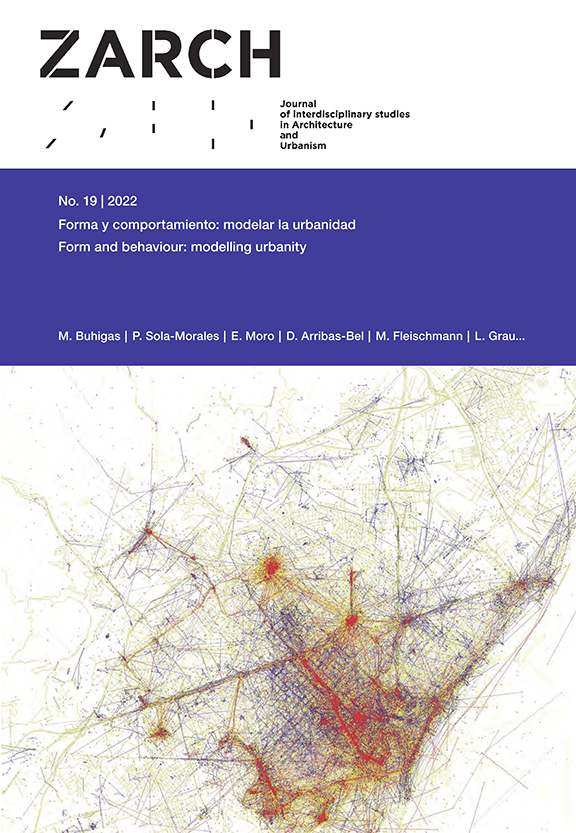Residential tissues in Guayaquil: urban indicators relating to compactness and functionality
DOI:
https://doi.org/10.26754/ojs_zarch/zarch.2022196923Keywords:
Urban morphology, residential areas, sustainable urbanism, GuayaquilAbstract
The Pascuales and Norte Zones represent the most recent advance of Guayaquil's urban footprint on the northern border of the homonymous canton. There coexist various residential forms that are making the city, at their own pace and with their own logics. This article aims to present a comparative analysis of residential fabrics based on the qualification of their morphology and the use of indicators related to compactness and functionality, one of the basic objectives of sustainable urbanism. The residential tissues were initially classified by their origin, type of promotion and permeability. The analysis, through a homogeneous comparison system and the use of quantitative parameters associated with compactness and functionality, makes it possible to visualize the neighborhood-scale behavior of this Ecuadorian city and establish a methodological scheme that can be integrated into diagnoses for planning purposes. The results point to important shortcomings in these fundamental contexts of local life, regardless of their origins and the actors involved in their production: deficit of public spaces, inadequate densities and insufficient mix of uses and urban functions.
Display downloads
References
Agencia de Ecología Urbana de Barcelona. 2012. Guía metodológica para los sistemas de auditoría, certificación o acreditación de la calidad y sostenibilidad en el medio urbano. Madrid: Centro de Publicaciones Secretaría General Técnica Ministerio de Fomento, Gobierno de España.
Banco Interamericano de Desarrollo. 2016. Guía metodológica del Programa de Ciudades Emergentes y Sostenibles. Banco Interamericano de Desarrollo.
Bozzano, Horacio. 2000. Territorios reales, territorios pensados, territorios posibles. Buenos Aires: Espacio Editorial.
Da Ros, Giuseppina. 2007. El movimiento cooperativo en el Ecuador. Visión histórica, situación actual y perspectivas. CIRIEC-España. Revista de Economía Pública, Social y Cooperativa (57), 249-284.
Hall, Peter. 1996. Ciudades del mañana. Historia del urbanismo en el siglo XX. Barcelona: Ediciones del Serbal.
Hermida, Augusta; Orellana, Daniel; Cabrera, Natasha Cabrera; Pablo Osorio y Christian Calle. 2015. La ciudad es esto. Medición y representación espacial para ciudades compactas y sustentables. Cuenca: Universidad de Cuenca.
López Bernal, Osvaldo y López Valencia, Adriana. 2015. Diseño urbano adaptativo al cambio climático. Cali: Editorial Universidad del Valle.
Mardones-Fernández, Nuño, Luque-Valdivia, José y Aseguinolaza-Braga, Izaskun. 2020. La ciudad del cuarto de hora, ¿una solución sostenible para la ciudad postCOVID-19? Ciudad y Territorio. Estudios territoriales LII (205), 653-664. https://doi.org/10.37230/CyTET.2020.205.13.1
Marín-Cots, Pedro y Morente del Monte, José María. 2018. La Manzana Verde. Nuevas Formas de Habitar. Málaga: Observatorio de Medio Ambiente Urbano.
Marín-Cots, Pedro y Palomares-Pastor, Macarena. 2020. “En un entorno de 15 minutos. Hacia la ciudad de proximidad y su relación con el Covid-19 y la crisis climática, el caso de Málaga”. Ciudad y Territorio. Estudios territoriales 205: 685-700. https://doi.org/10.37230/CyTET.2020.205.13.3
Ministerio de Desarrollo Urbano y Vivienda. 2015. Informe Nacional del Ecuador. Hábitat III. Quito: MIDUVI.
Municipalidad de Guayaquil. Gaceta Oficial N° 20 del 13 de febrero de 2015.
Naciones Unidas. 2017. Nueva Agenda Urbana. Naciones Unidas.
Observatorio de Medio Ambiente Urbano - OMAU. Ayuntamiento de Málaga. 2019. Agenda Urbana Málaga. Indicadores de sostenibilidad 2019. Málaga: Servicio de Programas del Ayuntamiento de Málaga- Observatorio de Medio Ambiente Urbano - OMAU.
Rueda-Palenzuela, Salvador. 2019. El urbanismo ecosistémico. Ciudad y Territorio. Estudios territoriales 202: 723-752.
Zapatero, María Antonia. 2017. La densidad urbana: Concepto y metodología. Análisis comparativo de los tejidos de Madrid. Tesis doctoral, Universidad Politécnica de Madrid.
Downloads
Published
Versions
- 2023-02-22 (2)
- 2023-02-11 (1)
Issue
Section
How to Cite
Accepted 2022-10-07
Published 2023-02-22







